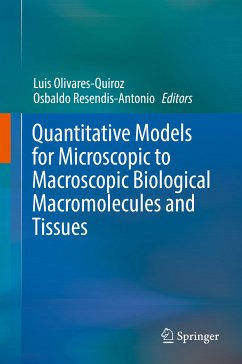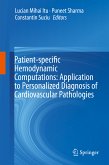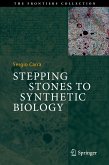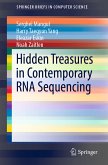Quantitative Models for Microscopic to Macroscopic Biological Macromolecules and Tissues (eBook, PDF)
Redaktion: Olivares-Quiroz, Luis; Resendis-Antonio, Osbaldo
72,95 €
72,95 €
inkl. MwSt.
Sofort per Download lieferbar

36 °P sammeln
72,95 €
Als Download kaufen

72,95 €
inkl. MwSt.
Sofort per Download lieferbar

36 °P sammeln
Jetzt verschenken
Alle Infos zum eBook verschenken
72,95 €
inkl. MwSt.
Sofort per Download lieferbar
Alle Infos zum eBook verschenken

36 °P sammeln
Quantitative Models for Microscopic to Macroscopic Biological Macromolecules and Tissues (eBook, PDF)
Redaktion: Olivares-Quiroz, Luis; Resendis-Antonio, Osbaldo
- Format: PDF
- Merkliste
- Auf die Merkliste
- Bewerten Bewerten
- Teilen
- Produkt teilen
- Produkterinnerung
- Produkterinnerung

Bitte loggen Sie sich zunächst in Ihr Kundenkonto ein oder registrieren Sie sich bei
bücher.de, um das eBook-Abo tolino select nutzen zu können.
Hier können Sie sich einloggen
Hier können Sie sich einloggen
Sie sind bereits eingeloggt. Klicken Sie auf 2. tolino select Abo, um fortzufahren.

Bitte loggen Sie sich zunächst in Ihr Kundenkonto ein oder registrieren Sie sich bei bücher.de, um das eBook-Abo tolino select nutzen zu können.
Covers a wide variety of topics ranging from microscopic biological systems to macroscopic biological systems
Offers insight from top researchers in the field of biological and mathematical physics
Ideal for both advanced undergraduate students and graduate students
- Geräte: PC
- ohne Kopierschutz
- eBook Hilfe
- Größe: 8.4MB
Andere Kunden interessierten sich auch für
![Patient-specific Hemodynamic Computations: Application to Personalized Diagnosis of Cardiovascular Pathologies (eBook, PDF) Patient-specific Hemodynamic Computations: Application to Personalized Diagnosis of Cardiovascular Pathologies (eBook, PDF)]() Patient-specific Hemodynamic Computations: Application to Personalized Diagnosis of Cardiovascular Pathologies (eBook, PDF)112,95 €
Patient-specific Hemodynamic Computations: Application to Personalized Diagnosis of Cardiovascular Pathologies (eBook, PDF)112,95 €![Multifractals and Chronic Diseases of the Central Nervous System (eBook, PDF) Multifractals and Chronic Diseases of the Central Nervous System (eBook, PDF)]() Dipak GhoshMultifractals and Chronic Diseases of the Central Nervous System (eBook, PDF)72,95 €
Dipak GhoshMultifractals and Chronic Diseases of the Central Nervous System (eBook, PDF)72,95 €![Drug Design: Principles and Applications (eBook, PDF) Drug Design: Principles and Applications (eBook, PDF)]() Drug Design: Principles and Applications (eBook, PDF)96,95 €
Drug Design: Principles and Applications (eBook, PDF)96,95 €![Channelopathies in Heart Disease (eBook, PDF) Channelopathies in Heart Disease (eBook, PDF)]() Channelopathies in Heart Disease (eBook, PDF)112,95 €
Channelopathies in Heart Disease (eBook, PDF)112,95 €![Stepping Stones to Synthetic Biology (eBook, PDF) Stepping Stones to Synthetic Biology (eBook, PDF)]() Sergio CarràStepping Stones to Synthetic Biology (eBook, PDF)46,95 €
Sergio CarràStepping Stones to Synthetic Biology (eBook, PDF)46,95 €![Introduction to Evolutionary Genomics (eBook, PDF) Introduction to Evolutionary Genomics (eBook, PDF)]() Naruya SaitouIntroduction to Evolutionary Genomics (eBook, PDF)48,95 €
Naruya SaitouIntroduction to Evolutionary Genomics (eBook, PDF)48,95 €![Hidden Treasures in Contemporary RNA Sequencing (eBook, PDF) Hidden Treasures in Contemporary RNA Sequencing (eBook, PDF)]() Serghei MangulHidden Treasures in Contemporary RNA Sequencing (eBook, PDF)40,95 €
Serghei MangulHidden Treasures in Contemporary RNA Sequencing (eBook, PDF)40,95 €-
-
-
Covers a wide variety of topics ranging from microscopic biological systems to macroscopic biological systems
Offers insight from top researchers in the field of biological and mathematical physics
Ideal for both advanced undergraduate students and graduate students
Offers insight from top researchers in the field of biological and mathematical physics
Ideal for both advanced undergraduate students and graduate students
Dieser Download kann aus rechtlichen Gründen nur mit Rechnungsadresse in A, B, BG, CY, CZ, D, DK, EW, E, FIN, F, GR, HR, H, IRL, I, LT, L, LR, M, NL, PL, P, R, S, SLO, SK ausgeliefert werden.
Produktdetails
- Produktdetails
- Verlag: Springer International Publishing
- Seitenzahl: 226
- Erscheinungstermin: 26. Februar 2018
- Englisch
- ISBN-13: 9783319739755
- Artikelnr.: 52938276
- Verlag: Springer International Publishing
- Seitenzahl: 226
- Erscheinungstermin: 26. Februar 2018
- Englisch
- ISBN-13: 9783319739755
- Artikelnr.: 52938276
- Herstellerkennzeichnung Die Herstellerinformationen sind derzeit nicht verfügbar.
Luis Olivares-Quiroz is currently full-time physics professor, researcher, and lecturer at Universidad Autonoma de la Ciudad de Mexico (UACM). He obtained his PhD in 2007 with a thesis on the statistical mechanics of protein folding and its connection to the glass transition. After receiving his PhD, he has been involved actively in research at the interface of physics and molecular biology, particularly on the application of statistical physics, stochastic process, complex networks, and genetic algorithms (GAs) to the analysis of protein folding and unfolding, peptide and protein translocation across membranes, identification of active sites in biological macromolecules as well as computer simulations of interacting potentials for protein folding using GAs. He has been invited to different research institutions both in Mexico and abroad: Department of Biochemistry, University of Arizona, Tucson (USA); Forschungszentrum (Germany); Faculté des Sciences, University of Nantes (France); Department of Physics, Georgia Tech at Atlanta (USA); and the Biophysical Sciences Institute at Durham University (UK). In Mexico, he has been an active and intense promoter of research in biological physics. In 2009 he was granted the National Prize for Science Dissemination for the publishing of a book on the quantum physics of ultracold liquids and gases. He has been also editor-in-chief of Physical Biology of Proteins and Peptides: Theory, Experiment, and Simulation published by Springer in 2015. Osbaldo Resendis-Antonio is professor of systems biology at the National Institute of Genome Medicine (INMEGEN) and the Research Support Network (RAIUNAM) at the National Institute of Medical Sciences and Nutrition Salvador Zubirán, both in México City. After receiving a Ph.D. in physics in 2003, he switched the emphasis of his research to systems biology, first as a postdoctoral fellow in the Institute Henry Poincare (France), the Center for Nitrogen Fixation-UNAM (México); and the Department of Systems Biology at the University of California San Diego (USA); and then as a principal researcher at the Center for Genomic Sciences-UNAM, México, in 2008. He has been visiting professor in the Systems Biology Department at Harvard Medical School (USA), the group of Bioinformatics and Systems Biology at the University of Rostock (Germany), and the Institute for Systems Biology at Seattle, Washington (USA). His research interest is focused to survey the metabolic pathway alterations associated with multifactorial diseases, such as cancer, through the integrative description among genome-scale metabolic reconstructions, high-throughput data, and the development of constraint based modeling.
Diverse protein-folding pathways and functions of beta-hairpins and beta-sheets.- MicroRNAs, gene's regulator in prostate cáncer.- Subdiffusive Transport in Heterogeneous Patchy Environments.- Molecular assembling of the bacterial injectisome: a nanomachine used to inject effector proteins.- Pressure-driven DNA denaturation: state of the art and perspectives.- In silico identification and gene expression analysis of CDF-like genes from Trichomonas vaginalis in response to Zinc.- Dynamical features of a biochemical interaction in a plant root hair cell; a long story short.- Homeostasis from a time-series perspective: An intuitive interpretation of the variability of physiological variables.- Looking for biomarkers in physiological time series.- Systems Biology, Metabolomics and Breast Cancer: Where we are and which is the possible destination in the clinic.- Local effective temperatures for the patterns of motion of active particles.
Diverse protein-folding pathways and functions of beta-hairpins and beta-sheets.- MicroRNAs, gene's regulator in prostate cáncer.- Subdiffusive Transport in Heterogeneous Patchy Environments.- Molecular assembling of the bacterial injectisome: a nanomachine used to inject effector proteins.- Pressure-driven DNA denaturation: state of the art and perspectives.- In silico identification and gene expression analysis of CDF-like genes from Trichomonas vaginalis in response to Zinc.- Dynamical features of a biochemical interaction in a plant root hair cell; a long story short.- Homeostasis from a time-series perspective: An intuitive interpretation of the variability of physiological variables.- Looking for biomarkers in physiological time series.- Systems Biology, Metabolomics and Breast Cancer: Where we are and which is the possible destination in the clinic.- Local effective temperatures for the patterns of motion of active particles.







